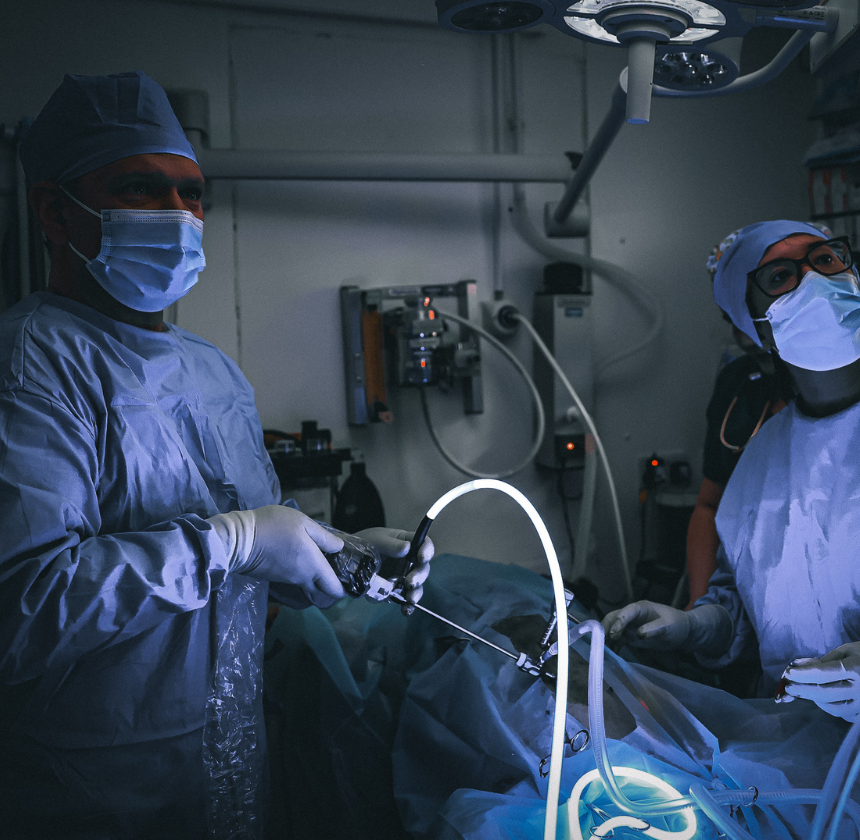Laparoscopic Biopsy
Offering advanced, minimally invasive biopsy procedures for accurate diagnosis.
What Is Laparoscopic Biopsy?
Laparoscopic biopsy is a minimally invasive procedure used to collect tissue samples from internal organs for diagnostic purposes. By using a laparoscope, a small camera inserted through tiny incisions, the veterinarian can carefully examine internal organs and take biopsies with minimal disruption to the surrounding tissues. This technique is ideal for diagnosing various conditions, including cancers, infections, and other internal diseases, while promoting faster recovery for your pet.
When is Laparoscopic Biopsy Recommended?
Laparoscopic biopsy may be recommended if your pet has symptoms that suggest an internal issue, including:
Abdominal Masses or Tumours
Chronic Abdominal Pain
Unexpected Weight Loss
Digestive Issues
Suspicious Growths on Organs such as Live, Kidneys or Spleen
Laparoscopic Biopsy Procedure:
Pre-Procedure Preparation
Before the procedure, your pet will undergo a thorough examination, including blood work and imaging studies (like X-rays or ultrasound) to assess their condition. These preliminary tests help guide the decision to perform laparoscopy and ensure that your pet is fit for anesthesia.
Anaesthesia and Sedation
General anesthesia is administered to ensure your pet is comfortable and completely relaxed during the procedure. This is necessary as the procedure involves examining internal organs.
Surgical Incisions
Small incisions, usually one or two, are made in the abdomen to insert the laparoscope and biopsy instruments. These incisions are much smaller than those required for traditional surgery, minimising tissue trauma.
Visualisation
The laparoscope, which is equipped with a camera, provides high-definition, real-time images of the organs. The surgeon can then locate the abnormal area, such as a mass or lesion, and examine it closely to determine the appropriate biopsy site.
The Biopsy
Once the target area is identified, the surgeon uses specialized instruments to remove a small tissue sample from the affected organ. This tissue will then be sent to a laboratory for analysis, allowing for an accurate diagnosis.
Closure & Recovery
After the biopsy is completed, the incisions are closed with sutures or surgical glue. Most pets recover quickly, with many able to go home the same day or the following day. Postoperative care includes monitoring for any complications, administering pain relief, and keeping your pet comfortable.
Laparoscopic Biopsy Benefits in Pets
Overall, laparoscopic biopsy offers numerous benefits for your furry friends, including precise tissue sampling, reduced postoperative pain, faster recovery, and a minimally invasive approach to diagnosing internal health issues.
Minimally Invasive
Small incisions lead to less pain, faster recovery, and reduced scarring compared to traditional surgical biopsy methods.
High Precision
The laparoscope provides clear, magnified views, allowing for accurate targeting of tissue samples from specific areas.
Reduced Complications
Minimises risks such as infection, bleeding, and other complications associated with larger incisions or open surgery.
Faster Recovery
Pets typically experience quicker healing times and can often return to normal activities sooner.
Improved Diagnostics
Provides high-quality biopsy samples, helping in the accurate diagnosis of tumours, infections, or other internal conditions.
Shorter Hospital Stay
Many pets can go home the same day, thanks to the minimally invasive nature of the procedure.

